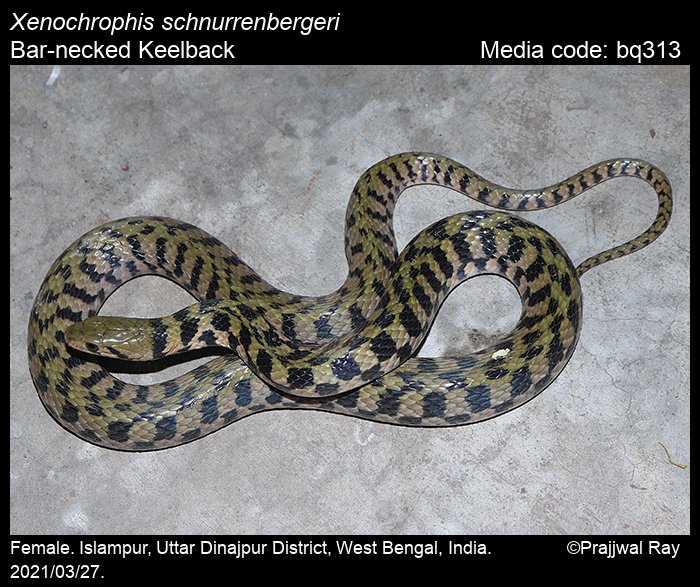Image

Gender (optional)
Life stage
Altitude (optional)
1305
Email (of contributor)
krushnamegh@ifoundbutterflies.org
Notes (optional)
Rescued from a temple where it was found within heap of offered flowers. While escaping on hard ground, doesn't sidewind like checkered keelback.
Total length – 2 ft approximately
Dorsal – 19:17:17 (1)
Ventral – 146 (indicates female)
Subcaudal – 56 (2) divided, terminal scute excluded
Anal – divided
Infralabial – 10 on the right side
Supralabial – 9 on the right side (4th, 5th touching eye)
Temporals – 2 + 2 on the right side
Loreal – 1
Nasal – sutured
Nostrils – positioned laterally
Preocular – 1 large
Postocular- 3
Anterior chin shields – 2
Posterior chin shields – 2 (larger)
Anterior subocular streak (right side) – Originates below the eye, spreading through the junction of 6th Supralabial, 7th Supralabial and 3rd postocular. Resembles a blotch rather than a streak.
Posterior subocular streak (right side) – Originates near the junction of parietal and first postocular, passing through anterior temporals and eighth Supralabial and eventually reaching the jaw angle touching eighth infralabial, one scale right below it and ninth infralabial.
Head and dorsum olive green, flanks yellow ochre in colour. Six longitudinal rows of blackish blotches run from behind the neck to tail, giving it a checkered pattern more precise than F. piscator. Ventral scales white, black borders present between two ventrals. Borders aren’t entire.
(1), (2) – The normal dorsal count for this species is 19:19:17 (Purakayastha et al 2010) which in our case is 19:17:17. However, odd number of scales has been reported previously from a specimen from Assam where the dorsal count was 21:19:19.
Also, the subcaudal count in this one (56) seems below normal range which is 64-79, according to Purakayastha et al 2010, but the same study has also documented an individual with 54 subcaudals.
Total length – 2 ft approximately
Dorsal – 19:17:17 (1)
Ventral – 146 (indicates female)
Subcaudal – 56 (2) divided, terminal scute excluded
Anal – divided
Infralabial – 10 on the right side
Supralabial – 9 on the right side (4th, 5th touching eye)
Temporals – 2 + 2 on the right side
Loreal – 1
Nasal – sutured
Nostrils – positioned laterally
Preocular – 1 large
Postocular- 3
Anterior chin shields – 2
Posterior chin shields – 2 (larger)
Anterior subocular streak (right side) – Originates below the eye, spreading through the junction of 6th Supralabial, 7th Supralabial and 3rd postocular. Resembles a blotch rather than a streak.
Posterior subocular streak (right side) – Originates near the junction of parietal and first postocular, passing through anterior temporals and eighth Supralabial and eventually reaching the jaw angle touching eighth infralabial, one scale right below it and ninth infralabial.
Head and dorsum olive green, flanks yellow ochre in colour. Six longitudinal rows of blackish blotches run from behind the neck to tail, giving it a checkered pattern more precise than F. piscator. Ventral scales white, black borders present between two ventrals. Borders aren’t entire.
(1), (2) – The normal dorsal count for this species is 19:19:17 (Purakayastha et al 2010) which in our case is 19:17:17. However, odd number of scales has been reported previously from a specimen from Assam where the dorsal count was 21:19:19.
Also, the subcaudal count in this one (56) seems below normal range which is 64-79, according to Purakayastha et al 2010, but the same study has also documented an individual with 54 subcaudals.
HighLighted Contributions
No
Species Node
Overwrite img

Organism
Butterfly
Butterfly Taxon search:
Hidden Life stage
Month
March
Year
2021
Day
27
Choose copyright license
Copyrighted (all rights reserved)